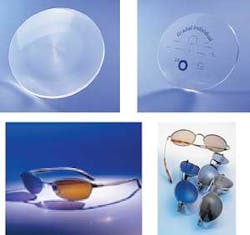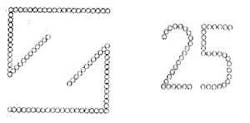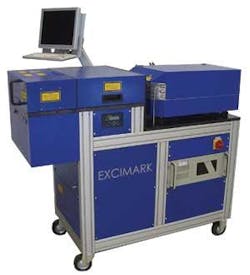Excimer lasers make their reliability mark
High reliability and predictable maintenance are key benefits in marking ophthalmic lenses in a volume production environment
Markus Haidl and Rainer Paetzel
Carl Zeiss Vision GmbH (Aalen, Germany), a leading manufacturer of ophthalmic lenses, marks all its high-value glass and plastic progressive and individual progressive lenses with its trademark “Z” logo. In addition, according to ISO standards, all progressive lenses are permanently marked with a unique alphanumeric string to identify the manufacturer, the lens type, and its focal properties. For several years the company has been using 248nm and 193nm excimer lasers to perform all this marking in an “on demand” production line. This article explains why and how excimers are used in this application and shares real-world experience about the cost, reliability, and productivity associated with running these lasers up to 24 hours/day.
The Carl Zeiss Vision production facility at Aalen is classified as a prescription (Rx) lab specializing in fast turnaround fabrication of high-quality lenses for the ophthalmic market (see Figure 1, below). The company processes orders from within Germany and throughout Europe. An order usually comprises two lenses characterized by the prescription data, that is, spherical and astigmatic power, orientation of the astigmatism, and several other parameters, including the lens type and type of coating. Because it is impossible to hold millions of different lens types in stock to accommodate each customer’s prescription, many of these orders have to be manufactured on demand, especially the most advanced “individualized” progressive lenses, which are now often preferred to the old style bifocals. Both mineral glass and lightweight plastic lenses are produced. Lenses made from organic material are usually covered with three types of coatings: a hard coat applied directly to the polished lens, an antireflection coating, and on top of them a so-called clean coat.
The lenses are marked at various stages of production for internal tracking purposes, to create the “Z” trademark, and to denote the precise lens characteristics (see Figure 2). This marking includes engraving lens molds, lens blanks, and polished lenses before coating; the final step is always engraving the finished coated lenses with the 2 x 2 mm2 trademark in a unique and patented process.
These surface marks must be clearly visible to the trained optician but relatively unobtrusive to the eyeglass wearer. For marks created in the mold or directly on an uncoated lens, this means that the mark should have enough depth so that it does not become invisible by the coating processes. Marks created on the coated lenses must be highly precise with very clean edges that are free of microcracking. This eliminates the risk of coating delamination during wear and cleaning.
Excimer lasers
Carl Zeiss introduced laser engraving more than 10 years ago when the majority of lenses were still made from mineral glass. For this purpose, engraving with 193 nm gave the best results on those materials, including antireflection coatings. Several laser technologies were evaluated, including Q-switched solid-state at 1064 nm and CO2 at 10.6 µm but they all were found to be not applicable. The excimer laser could produce marks that were demonstrably superior to the other laser types. Specifically, the excimer’s direct ablation with almost no thermally affected area due to short pulse length, low optical penetration depth, and homogeneous energy density created marks free of peripheral thermal damage and microcracking, unlike the longer wavelength lasers that rely on thermal processes.
Based on this process evaluation, the company purchased a custom-made engraving station from Optiray Laser GmbH (Munich, Germany) that incorporated a 248nm excimer laser (ExciStar S-200) from Tui Lasers (now part of Coherent Lambda Physik, www.coherent.com).
Because these marks change from lens to lens, the system does not rely on the fixed mask projection optics typically utilized for excimer laser processing. Instead the beam passes through a circular aperture, which is de-magnified onto the lens. This spot is then scanned across the work surface using twin galvanometer mirrors. The marks are thus created as a series of dots.
This first laser system was used exclusively to mark uncoated plastic substrates (248 nm is not optimum for marking glass lenses or coated lenses). Based on its successful implementation, Carl Zeiss purchased additional workstations, including systems equipped with a 193nm excimer laser (see Figure 3). Some of these workstations were installed at Aalen, the others at different company prescription laboratories around the world. As expected, the 193nm wavelength proved to be very versatile and is now used to mark lens molds, plastic, and glass substrates and both coated and uncoated lenses.
Volume throughput
During production, each lens is individually engraved while mounted in a block-usually the same block used to hold the lens while being ground, polished, and finished. This block is manually inserted into a chuck and collet assembly in the marking workstation. The cover is then closed and the marking process is initiated through the system software.
Each laser workstation can process up to four lenses per minute, based on a less-than-five-seconds time interval for the actual marking and the rest for handling and positioning. The exact time for the marking depends on the mark complexity and the depth of the mark. Each mark is written as a series of dots. The minimum depth mark is made by using one laser pulse per dot. Deeper marks are produced using between two and five pulses/dot. For example, a total of 300-500 laser pulses are required to produce a permanent mark on an uncoated lens. Producing a permanently visible mark on a mold typically requires up to 1000 pulses. Of course, mark visibility is ultimately a subjective judgement-the goal is to make the mark clearly visible to the trained optician while making it as unobtrusive as possible to the wearer.
This marking process is significantly faster than the other lens fabrication processes, so a single laser workstation can support several grinding/polishing machines. The company is steadily increasing the product volume at the Aalen plant, and the laser workstations are operating in three shifts. This translates into a nominal maximum capacity of several thousands of engraved lenses per workstation per day.
Excimer laser advances
Until recently, excimers had a reputation for high maintenance costs and only modest reliability. This situation has changed dramatically, in part due to the development of high-reliability excimers for demanding, high-volume applications such as microlithography and silicon annealing (used in the fabrication of flat panel displays), that delivered tangible reliability benefits to other industrial applications, including glass marking. For example, Carl Zeiss Vision has a target value of around 90-95 percent net up-time for all plant equipment, irrespective of technology type. All the excimer workstations at the Aalen plant now meet this target.
This has been accomplished through the development of all metal/ceramic tube technology, which prevents contamination of critical components in the highly reactive discharge environment. When the company began this marking application, the tube lifetime was sometimes as short as a few thousand hours. But with the new metal/ceramic tubes, they have not replaced a single tube in the past two years of operation. In fact, the long tube lifetime has redefined the spare part replacement philosophy. A stock of small components, such as mirrors and windows, is maintained and the process development workstation is used as a spare system. In the rare event that one of the production workstations is temporarily out of action, the development machine can be substituted with no disruption to productivity. This approach has proven more cost-effective than purchasing a spare tube.
Laser gas, particularly for 193 nm, is one of the main excimer laser consumables. Moreover, emptying the laser tube and replacing the gas used to be a time-consuming manual task. Metal/ceramic tube technology, together with an improved electro-static gas filtration system, delivers substantially longer gas lifetime. Onboard power-stabilization electronics ensure that there is no degradation in laser power as the gas ages. In addition, gas re-filling is now automated, and each laser is automatically re-filled after up to 8 million shots. All this translates into the consumption of only one 10-liter bottle of pre-mixed gas per laser per year (the typical cost of a single gas bottle is around €600).
Another benefit of the improved gas filtration system is that the laser windows stay cleaner much longer and are now replaced only about once a year on average. Window cleaning is performed as a routine maintenance task every 40-50 weeks.
Microprocessors in both the workstation and laser enable simple pushbutton operation of the entire system, thus only two days’ training is required for a new operator. Several of the company’s personnel have also received two days of service training by the laser manufacturer and they are responsible for the support of the lasers in production.
These advances have significantly reduced the operating costs for the lens marking systems. In fact, the single largest cost in the marking operation is now associated with operator time for manual handling of the lenses.
Conclusion
Several years of utilizing excimer lasers to mark glass and plastic lenses, as well as lens molds, has shown the high reliability, ease of operation, and low maintenance downtime of these systems, proving that the excimer laser is a viable tool for volume industrial processing.
Dr. Markus Haidl is with Carl Zeiss Vision GmbH (Aalen, Germany) and Rainer Paetzel ([email protected]) is with Coherent Lambda Physik GmbH (Göttingen Germany).




